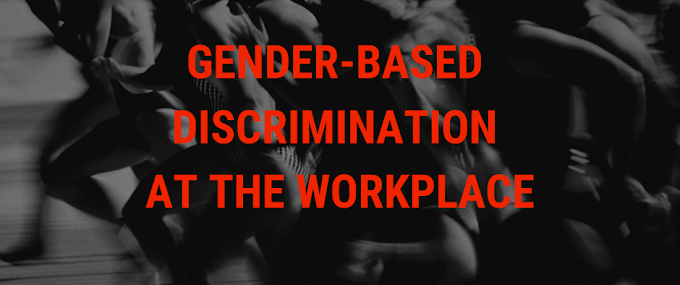GENDER-BASED DISCRIMINATION AT THE WORKPLACE
Unfortunately, after so many decades of continuing our society and economy, gender discrimination in the workplace persists to be a significant concern. For both males and females, though it is prohibited by many countries globally.
It happens in direct and
indirect ways; Direct discrimination means receiving an unusual and often
adverse response because of bias against that person's sex.
On the other side, the best example to understand indirect discrimination is when people make unreasonable assumptions about which job is suitable for women and which is good for men, and accordingly make decisions based on discriminatory gender stereotypes.
According to many research papers, more than 40 percent of women are the victims of gender discrimination and face it in many forms in their daily job lives.
Gender Prejudice affects the employer's decisions when hiring or giving promotion, but it also negatively affects other employment conditions such as less salary and no perks.
We need to understand that it's not just a "women" issue, as many people assume it is that thousands of male workers are also facing it every day.
Dealing with bias and
eliminating discriminatory practices is not easy and requires a continuous
effort. It's better to know how gender discrimination affects both males and
females in their work lives.
DISCRIMINATION AGAINST WOMEN AT THE WORKPLACE
Despite years of protests and movements against this exploitation, including laws against gender discriminatory practices, millions of women are still suffering due to gender bias, especially at their workplace.
There are so many forms of gender inequality that women are facing in their regular lives.
According to many studies, women get only 80 percent, or less of their male counterparts earn the same workload. While deciding on the salary employers make is based on gender, this is the primary cause behind this disparity.
There are also fewer job opportunities available for them than their male counterparts. This is a very wrong assumption that women are not fit for work both physically and mentally.
Also, conditions differ for most of the women from that of male employees because of this work.
If we talk about promotion opportunities, then the famous "glass ceiling" concept comes into play, according to which an artificial hindrance based on gender bias doesn't let any advancement in women's careers.
Even after witnessing so many live examples of successful women entrepreneurs and leaders, they don't get higher posts or executive posts.
We can not neglect the fact that
daily thousands of women employees have to face sexual harassment. They have
often asked for sexual favors or being in a relationship in return for a
promotion or salary hike even when they deserve that.
MALE DISCRIMINATION AT THE WORKPLACE
Yes, gender bias against men happens less often than females, but what here matters is its existence.
As per statistics, most companies tend to hire or promote generally younger over older and taller over shorter men.
In many career fields such as sales, most men face gender discrimination because women employees are favored over them.
We can take secretarial jobs as one more example, here also female employees are preferred over men. Therefore men are more likely to be denied such positions.
Women are given a more flexible schedule than men; in many companies, women can leave earlier or have more days off, but this privilege is not there for men. Many male employees are victims of sexual harassment, as well as women.
Every organization and its directors who run them must do more to ensure that both women and men have an equal opportunity to lead.
The following are some ways through which companies can ensure an impartial and positive environment.
GET WOMEN ON SENIOR POSTS
As we read above, women usually don't get higher posts because of negative stereotypes against them; here, the companies should recognize the barriers that hindered women's advancement.
More excellent representation of women on higher posts will break the stereotypes and encourage more women to take steps towards their advancement.
Companies have to work towards an inclusive approach. They should give both genders equal opportunities to show their abilities and skills. In the long run, it will increase companies' efficiency and productivity and make their image better in the market.
AN IMPARTIAL AND FAIR RECRUITING PROCEDURE
To ensure fair gender diversity in the workforce, organizations must first ensure whether their recruiting is fair.
It is essential to ensure that
the least job requirements are not so high that they exclude women and
encourage fresh talent and judge them according to their abilities and skills,
not on their gender.
EDUCATE THEIR EMPLOYEES
Organizations need to make assure that their employees are aware of their rights and also laws regarding gender discrimination.
They can impart training and, through which they should explain the benefits of gender equality and how it leads to the diversity of ideas, which can create a significant difference.
Organizations must also teach
all their employees how to report gender discrimination if it happens with them
or witness it.
REMOVE THE GENDER PAY GAP AND BRING TRANSPARENCY
Organizations have to ensure a transparent framework regarding salary procedures and eliminate the secrecy culture at their workplaces.
It will instill confidence and
surety among the employees about their companies' management to treat their
employees equally.
PROPER GRIEVANCE MANAGEMENT SYSTEM
In every organization, the availability of a robust grievance management system should be one of the employer's top priorities. It will hear employees' concerns and try to solve them as soon as possible.
They need to understand that a dissatisfied employee will express her concerns and negative experience outside, negatively affecting its image and reducing employees' retention rate.
It's high time that we realize this issue's seriousness and work towards it with full unity and determination.
We all have to raise our voices for a better tomorrow





0 Comments